We often talk about having 'good' or 'bad' circulation, but what exactly does it mean and how can you boost yours?
🕒 7 min read
The circulatory system, also known as the cardiovascular system, helps to control the flow of blood around your body. It's made up of blood vessels (around 60,000 miles of them), which carry blood towards and away from your heart.
Arteries move blood away from the heart, and veins carry it back. Your circulatory system also delivers oxygen, nutrients and hormones to cells in your body and carries away waste such as carbon dioxide. If it gets clogged or blocked, for whatever reason, the blood doesn't move as it should, and this leads to poor circulation.
Bad or poor circulation is not a disease in itself, but it is a symptom of many conditions and is generally defined as not getting an adequate supply of blood to a certain area of the body. Blood flow can also get worse in the winter, as the cold can make blood vessels go into spasm, particularly in the fingers and toes.
Signs of poor circulation
Areas that are typically affected by bad circulation such as the hands, legs and feet can feel cold as less oxygen and blood reaches them.
Other symptoms can include:
- Chilblains: itchy, purple, painful inflamed areas.
- Cramps.
- Tingling and swelling in the affected areas.
- Changes to skin colour: your fingers and toes can turn a blue or purplish colour.
- Digestive problems: decreased blood flow and oxygen to the intestines can cause abdominal pain.
- Dizziness on standing: frequently feeling lightheaded when you get up could suggest there isn't enough blood getting to your brain.
- Fatigue: poor circulation causes blood flow to be slower, and this can sap your energy.
- Erectile dysfunction: this commonly affects those with diabetes.
- Varicose veins: these enlarged veins are a signal that your valves are not functioning properly.
- Slow wound healing: blood carries oxygen, nutrients and white blood cells to help heal any damaged tissue, but if your circulation is compromised it can make it harder for enough blood to get to the affected area and so delay healing.
What causes poor circulation?
Poor circulation is often a problem of ageing (the over-40s are more prone to it) and is commonly a side-effect of conditions like diabetes, atherosclerosis (plaque build-up in the arteries) and Raynaud's phenomenon. Smoking, a sedentary lifestyle, being overweight and poor diet can all contribute to circulation problems.
The best supplements for circulation
An increasing body of research suggests that a variety of supplements could help encourage healthy circulation. These include:
Vein-vine (red vine leaf extract)
Red vine leaf extract has been shown to help contribute to good blood flow in the legs, and is particularly recommended if you spend lengthy periods of time either sitting or standing.
Research has shown that it helps improve signs and symptoms of a condition known as chronic venous insufficiency (CVI), which can include feelings of tiredness and 'heaviness' in the legs, muscle cramps, leg pain and varicose veins.
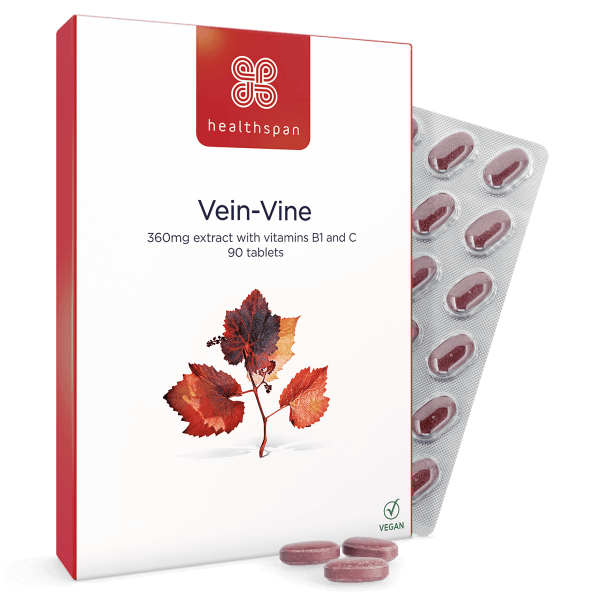
Vein-Vine
5,400mg red vine leaf for tired and heavy legs
- Red vine leaf contributes to good blood flow in the legs
- Can reduce the feeling of tired and heavy legs
- Added Vitamin C to help collagen formation for normal blood vessel function
Pycnogenol
Pycnogenol is extracted from French pine bark, and offers a range of benefits for circulation. In one study it was shown to reduce abnormal blood clotting, even in smokers – in a similar way to aspirin but without the side effects associated with regular aspirin use. It is also known to make blood platelets less 'sticky' and so reduce blood clots.
In another study pycnogenol was shown to help patients with chronic venous insufficiency. Those in the study were given three 100mg tablets daily for two months, after which 60% of participants reported a complete disappearance of oedema (swelling caused by too much fluid trapped in the body's tissues, most commonly seen in the legs and feet) and a reduction of pain. Almost all study participants said that their feelings of leg heaviness disappeared.
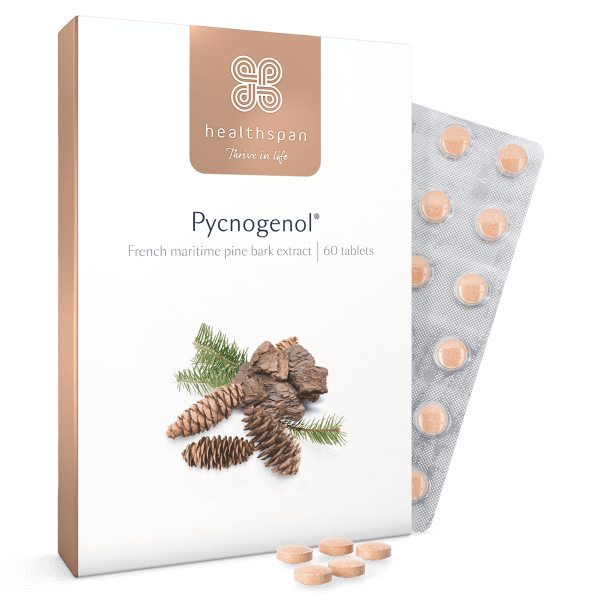
Pycnogenol®
Naturally powerful French maritime pine bark extract
- Unique blend of natural bioflavonoids
- Find out more at Pycnogenol.com
Circulease
The Fruitflow® in Circulease is a patented ingredient derived from the jelly-like substance surrounding tomato seeds, which has been shown to improve blood flow and circulation. It has also been shown to reduce platelet aggregation (when platelets become 'spiky' and can stick together, leading to blood clots.)
Circulease ensures platelets remain smooth, allowing them to move freely into blood vessels and contributing to healthier circulation.
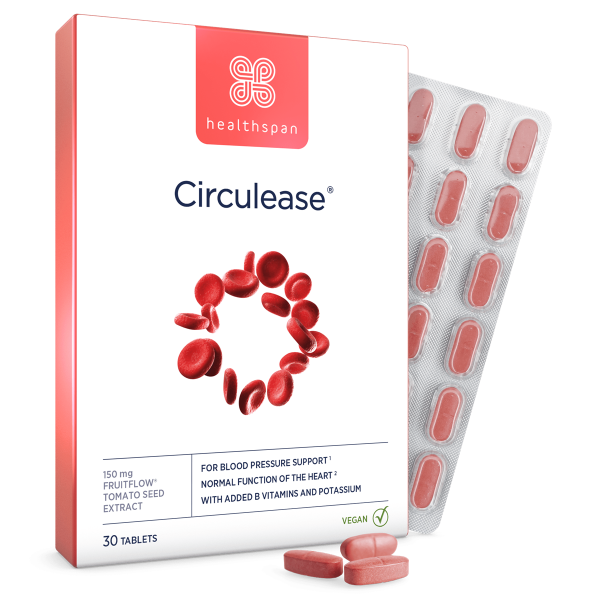
Circulease®
Provides natural support for a healthy blood flow and cardiac function
- Advanced formulation containing Fruitflow®
- Supports normal red blood cell formation
- Helps maintain normal blood pressure
Ginger
Research suggests that this spice may help to lower blood pressure. It has also been shown to thin the blood, making it easier for it to be pumped efficiently around the body.
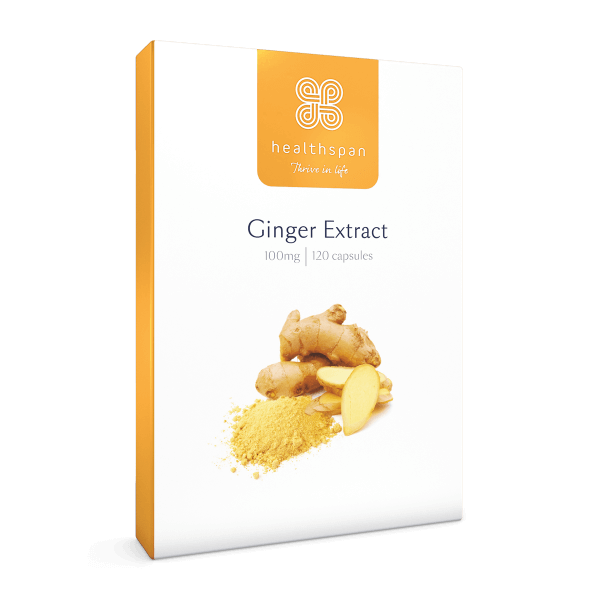
Ginger Extract
Equivalent to 12,000mg of whole ginger root
- Helps to support digestion
- Providing 20mg gingerols
- Standardised extract
Ginkgo biloba
This herb has been found to improve blood flow to the peripheries. In one trial participants diagnosed with Raynaud's syndrome were given gingko for 10 weeks, resulting in a 56% reduction in Raynaud's attacks compared to placebo. Research also links gingko biloba to improved blood flow to the brain.
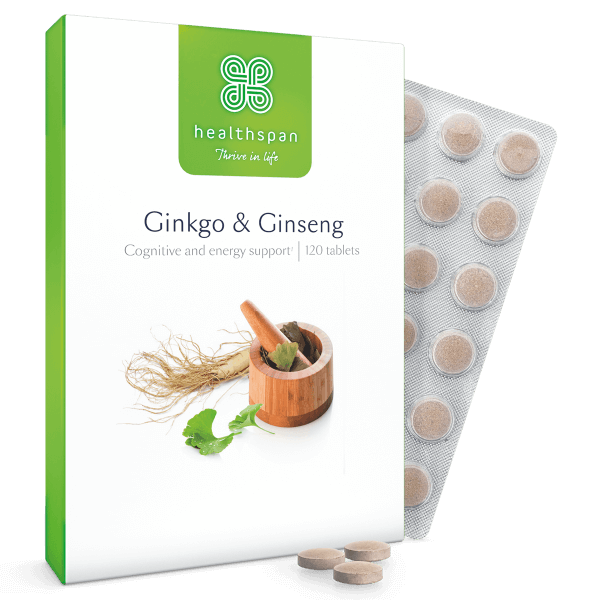
Ginkgo & Ginseng
For cognitive and mental performance
- Contributes to cognitive function and mental performance
- Supports energy metabolism and combats tiredness and fatigue
- High-quality ginkgo biloba and panax ginseng extracts
Curcumin
A meta-analysis has shown that taking curcumin supplements (the active ingredient in turmeric root) for 12 weeks significantly lowers blood pressure, particularly in women.
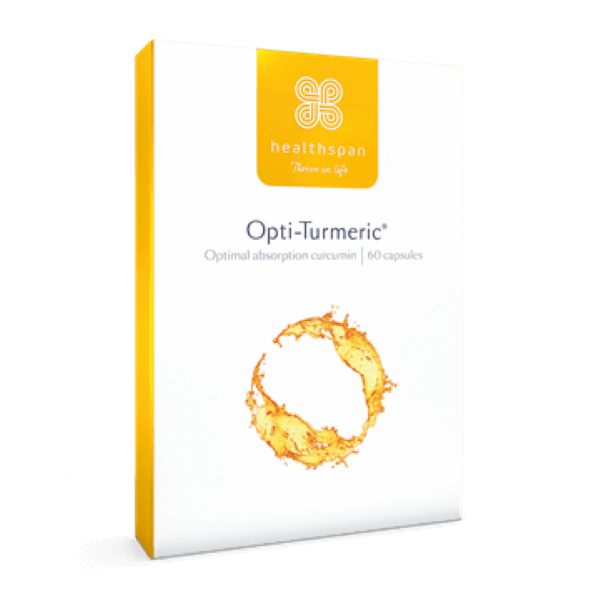
Opti-Turmeric
7 times faster-acting than standard turmeric
- Advanced liquid curcumin capsules
- Faster-acting and better absorbed than standard turmeric
- 500mg turmeric per capsule
Garlic
This kitchen staple contains an ingredient called allicin, which is known to help blood vessels relax. Studies show that people who regularly eat plenty of garlic in their diet tend to have blood that flows more efficiently. Research reveals that supplementing with garlic helps to increase peripheral blood flow.
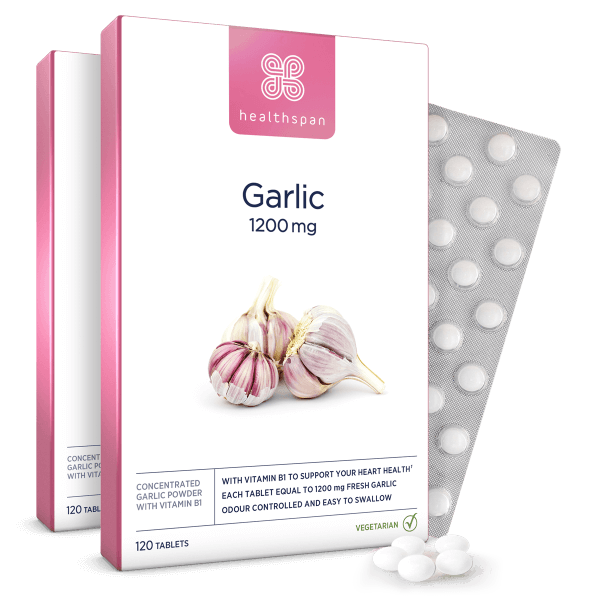
Garlic 1200mg
Supports heart health and the respiratory system
- Super-strength garlic tablets equivalent to 1,200mg fresh garlic
- Standardised extract to provide high yield of allicin
- Added vitamin B1 to support a healthy heart
10 other ways to improve your circulation
- Take regular exercise. Evidence shows that regular cardiovascular exercise can improve circulation, is associated with improved cardiovascular health and can contribute to lower blood pressure. It can also help you to keep your weight down; being overweight can potentially lead to problems with your circulation.
- Check your blood pressure. Take regular blood pressure readings to ensure yours is within a healthy range (you should be aiming for a reading of around 120/80.) This can be done by a nurse at your GP surgery, at your local pharmacy, or you can do it yourself (the British Heart Foundation has a list of approved models for home use). If blood pressure is too high for too long it can cause arteriosclerosis, a condition that can harden your arteries and choke off the blood supply.
- Get up and walk about regularly. This is particularly important if your job or lifestyle is mainly sedentary; aim to get up every hour to walk around and maybe grab yourself a glass of water or a cup of tea. Moving will work the valves in your leg veins and send blood up to your heart.
- Have a cup of tea. The antioxidants in both black and green tea have been shown to improve the health of blood vessels, which can help improve circulation.
- Drink more water. Around half of your blood is water, and drinking enough can help improve blood flow. Try to drink around 6-8 glasses a day (this can include squashes or herbal teas) but you might need more if you exercise regularly or in warm weather.
- Stop smoking and try to avoid being around people who do. Chemicals in smoke can damage the walls of the arteries and cause blood to thicken so it can't flow freely.
- Eat a circulation-boosting diet. We all need healthy fats in our diet but too much of the unhealthy ones like saturated fats (found in fatty cuts of meat, dairy products and biscuits, cakes and sweets) and trans fats (found in ultra-processed foods like many ready meals and foods like margarine, crisps, biscuits and cakes) can lead to a build-up in your arteries.
Healthy omega 3 fatty acids, on the other hand, found in oily fish (and also avocados, nuts and seeds and soybeans) have been shown to improve cardiovascular health and circulation. Supplements containing omega 3 may be helpful if you do not eat, or just don't like, fish. The BHF also recommends reducing your intake of salt, as too much can result in high blood pressure. - Maintain a healthy weight. Carrying extra weight can negatively affect circulation, as it puts the heart under pressure, increasing the amount of work it has to do. One study has shown how losing weight significantly improved circulation in overweight premenopausal women.
- Wear compression socks. Compression socks, stockings or bandages can help improve blood flow by gently squeezing your legs and feet and encouraging the blood to flow more efficiently back to your heart.
- Try dry body brushing. Use a firm, flat brush on your skin to encourage blood flow. Start at your feet and work your way up your body along your legs, stomach, arms, hands and back using firm, long strokes. Try to do this daily when your skin is dry.







